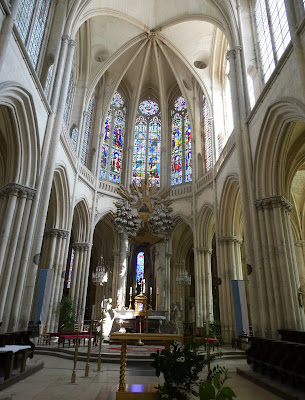We left Sens just before 9 a.m. (lock opening time) on July 6, no longer in the company of Csvargo (who had departed a day earlier), but with new travel companions from England, Betty and Paul, on a 12-meter motor yacht. It was a good "partnership", and we passed through the locks--whether they had flat sides or sloped sides with pontoons--with no problems and no delays. At the end of the 4-hour cruising day an unoccupied halte nautique awaited us in Villeneuve-sur-Yonne. By the end of the day, there were several more boats behind us.
With only the afternoon to see what the town had to offer, we were at the Tourist Office when they opened at 2 p.m. after the lunch break. We thought to pick up a walking tour map and head out, but what we got was so much more. The Tourist Office apparently shared space and staff with the Musee-Galerie Carnot, and the curator sat us down in an interior courtyard while she cleaned pottery shards from an archeological dig, and gave us a very humorous accounting of the history of Villeneuve. She then invited us to wander the art gallery for a brief period, before rejoining us to continue our personal guided tour and history lesson.
 |
| Left: native son, sculptor Emile Peyrot; U/R: "Lu", curator of the Carnot Museum and Gallery (and maybe director of the Tourist Office?); L/R: some of the displays in the Art Gallery. |
 |
| In a not-open-to-the-public room full of archeological finds, Lon and I got to hold a fragment of a mammoth tooth. As a parting gift, we were given a small stone knife from the Mesolithic era. |
 |
| The "Sorcerer's Tower", a portion of the old fortifications, was incorporated into this residence. |
 |
| The stone base of the Bonneville Tower, formerly the southwestern tower of the city walls, now part of a house along the Yonne. |
 |
| The Big Tower, the castle keep commissioned by King Philippe Auguste in 1205. |
 |
| Interior of the Church of Notre Dame de l'Assomption (13th-16th centuries). |
 |
| The chapel dedicated to St. Nicholas, patron saint of mariners. |
 |
| It's a very large church for what is now a rather small town, but truly reflective of the town's past importance. |
 |
| The two remaining fortified gates: Porte de Sens (L) and Porte de Joigny (R). |
Joigny is an older town than Villeneuve, with origins in Neolithic times. It, too, was fortified in the Middle Ages, and is noted for having one of the largest sets of half-timbered houses in Burgundy. We had originally intended to spend two nights in Joigny, but the weather forecast for Sunday was calling for thunderstorms all day, and we thought that it would be better to keep moving and have our "day off" in Gurgy on Sunday. As well, the mooring options for barges weren't great in Joigny, and the number of boats that we were seeing--both barges headed to the rally and vacation hire boats from the Locaboat/LeBoat hire base in Joigny--also made us think that moving on earlier was a better option. We saw what we could of Joigny in the little bit of time we had, and promised ourselves to return next year. We then enjoyed some camaraderie with DBA members who shared our mooring, and finished off the day by dining out to celebrate our 44th wedding anniversary.
 |
| Joigny spreads out on a hill. This view is from a park very near to where we were moored. |
 |
| Looking back toward the Locaboat port. Beyond the port, behind the trees, was our mooring spot. |
 |
| The Porte du Bois (Wood Gate). |
 |
| Lon trekking uphill on one of the narrow streets of Joigny. |
 |
| Some of the wood carvings on the 16th century timbered buildings are absolutely fabulous. |
 |
| Our view toward the back of the lock from our position in about the middle of the first lock of the day. |
 |
| Leaving the second lock: the first two boats continued with us to the village of Gurgy, whereas the boat in front of us left our group at this point to moor on a quiet quay. |
 |
| We were at one end of the mooring quay. Boats had to double up all the way along the quay to accommodate everyone who needed a place to stay overnight. |
 |
| "Leo" was aboard a boat that we invited to raft against us on July 9 when there was no open space on the quay in Gurgy. He had been a breeding stud, and his registered name was "Just a Gigolo." |
 |
| Auxerre at sunset. To the right, CARIB is seen moored under the pedestrian bridge, to the left is visible the Abbey of Saint-Germain d'Auxerre. |
 |
| As we headed back from an evening walk to the rally site, we saw the Auxerre Cathedral backlit by a beautiful orange sky. |
 |
| The view of the Cathedral out our window this morning. |



No comments:
Post a Comment